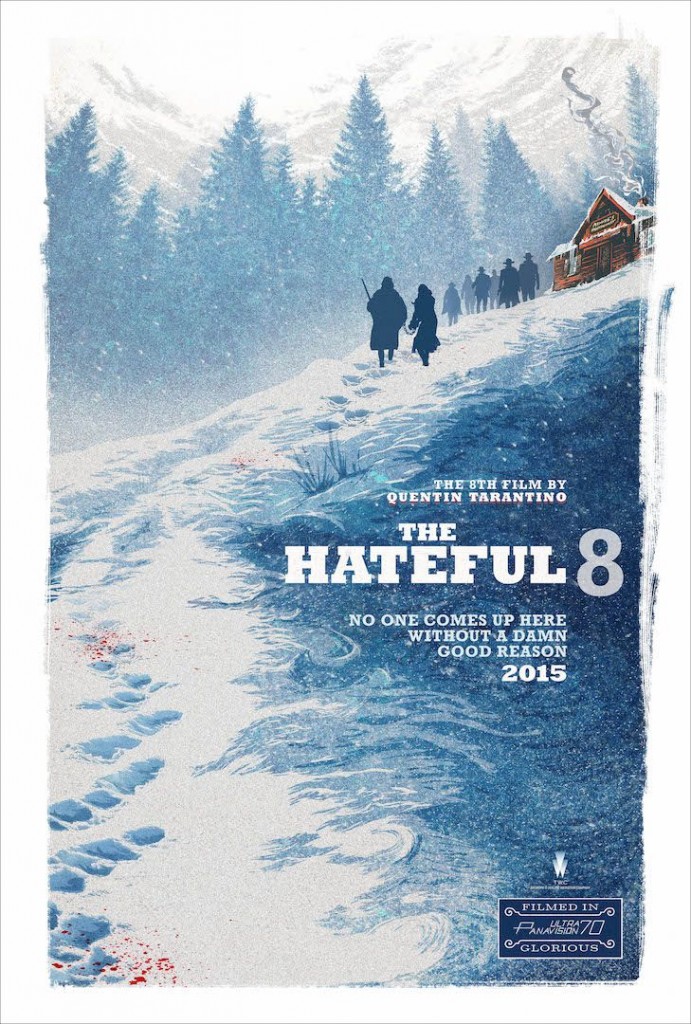By Mitch Huttema (The Cascade) – Email
Director Quentin Tarantino is holding out hope for film stock. His latest film, The Hateful Eight, was released in a special 70mm Roadshow format on Christmas Day in only three Canadian theatres and approximately 100 theatres worldwide, with old film projectors hauled out and retrofitted to project the film how Tarantino intended it.
Thanks to Tarantino, Abrams, Nolan, Apatow, and other directors, Kodak CEO Jeff Clarke said to The Hollywood Reporter that film stock production will likely return to profitability by this year.
I was able to see both the digital and 70mm formats of the film, and the difference between the two is surprising. I was unaware of the difference in cutting between the two screening formats until I saw the second and noticed a specific and memorable chicken plucking scene was absent. According to Variety magazine, Tarantino cut each version of the film differently, claiming that he felt certain scenes wouldn’t translate as well from film to digital. The 70mm version of the film had rich, lush colour compared to digital, and the very faint flicking of the projector could be heard as a pleasant white noise throughout the screening.
Due to the age of many of the projectors used to screen the 70mm version of the film, breakdowns and issues were common. Thirty minutes before the halfway mark of the film, the gate of the projector broke, rendering the entire centre of the frame out of focus. This was unable to be repaired and so the rest of the screening went on despite the issue. Several diehard fans left out of frustration, demanding refunds, but more than 95 per cent stayed. Regardless of the barely decipherable centre of the frame, the film was still immensely enjoyable to watch. Upon the end of the showing each guest was offered a free pass to see the digital version as compensation for the broken projector.
I found that the digital version of the film left a completely different impression on me than the 70mm. The image on the screen was much more crisp, devoid of flaws, and lacked the flicker of the 70mm version. All of this contributed to making the film feel like more of a blockbuster, and less of an art film.
The 70mm version started with an eight-minute overture, and breaks for a 12-minute intermission halfway through, both of which were lacking in the digital version. These two factors along with Tarantino’s use of chapters made the 70mm version of the film feel more like a play than a movie. The lighting of the film is also reminiscent of stage lighting: harsh, often disregarding any realistic light source. The film is set mainly in one room, just as in Reservoir Dogs. The actors don’t feel trapped, but rather like they are strutting to and fro across a stage. Their acting is over the top, very loud, and well enunciated, very similar to Woody Allen’s Magic in the Moonlight. Half of these characteristics are in both versions of the film, but there is something about having an intermission where everyone can run out, have a smoke break, and speculate together over where the rest of the story is going that is specially related to viewing a play.
In this year’s director roundtable from The Hollywood Reporter, Tarantino talked once again about his old promise of only making 10 films, but with a new twist: he now says that once he is done with films he wants to move on to write plays and direct on Broadway. It’s not surprising that he leans this way, as so many of his films would translate well to the stage.
The Hateful Eight is hard to watch at times; Tarantino has never been one to shy away from violence and abuse, and this film is no exception. He depicts racism, violence against women, and themes of power, control, and lies.
Despite its grim tone, this is Tarantino’s most majestic-looking work to date. The vistas of a wintery Michigan are painted across the screen, and a marvellous soundtrack by Ennio Morricone drives the visuals home. The characters are all charming and mischievous with some of the best writing of any of his films yet. Tim Roth’s character has the most delightful wit of all, with his most memorable quip being: “Gentlemen! Gentlemen! I know Americans aren’t apt to let a little thing like unconditional surrender to get in the way of a good war, but…”
All things considered, The Hateful Eight is unmistakably a Tarantino film. From the frivolous and cartoony gore to the revisionist history, nothing is left without his signature stamped upon it. Tarantino pushes the traditional journey or progress driven narrative aside, and puts eight personalities together in a sort of test tube to experiment with and investigate the rules of justice, truth, respect, and how far people (mostly men) are willing to travel for power and survival.



